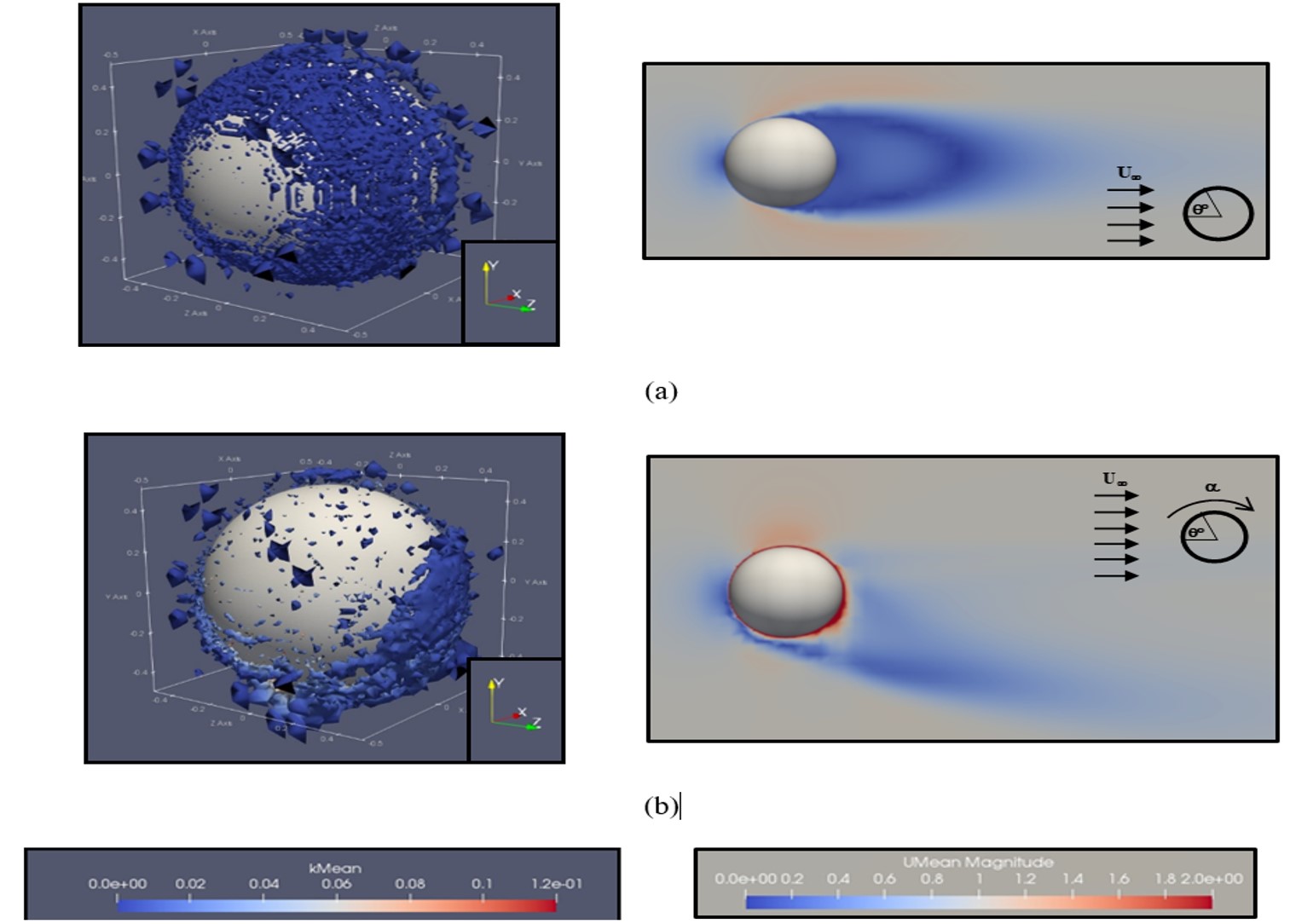The computational modelling in the prediction of flow past a rotating sphere at high Reynolds number
Main Article Content
Abstract
The present study has been purposed to predict the convective flow past a rotating sphere at high Reynolds numbers of 10,000, 70,026 and 96,000. The turbulence effects have been examined using the Reynolds stress model (RSM), and strengthens the model effectiveness on strongly curvature surface flow, which the individual form of fluctuation terms have been provided in the second moment closer relating to each physical reason. The RSM has been also used in combination with the strategies of near-wall turbulence of standard log-law-based obtaining the lower computational resource. The predicted result has been assessed through comparisons with available experimental and the present U-RANS approach. The RSM presents a high accuracy result in 3 dimensional flow according to the unpredictable aerodynamic forces along with time history. The lift (CL), drag (CD) and side force (CS) coefficients have been predicted with a wide range of spin ratios up to 5. The maximum values of CL and CD have been found at 0.37 and 0.64 for a rotating sphere, and those of aerodynamic forces have changed with spin ratios.The rotating sphere leads to suppress the wake strength and size downstream.Significantly, the pressure distribution is an asymmetric structure concerning the magnitude of lift, drag coefficients. This research has confirmed that the RSM has been a highly competent approach to examine the convective flow past a rotating sphere at high Reynolds number.
Article Details

This work is licensed under a Creative Commons Attribution-NonCommercial-ShareAlike 4.0 International License.
This work is licensed under a Creative Commons Attribution-NonCommercial-ShareAlike 4.0 International License.
References
Magnus, G. Ueber die Abweichung der Geschosse, und: Ueber eine auffallende Erscheinung bei rotirenden Körpern, Annalen der Physik, Vol. 164(1), 1853, pp. 1-29.
Kray, T., Franke, J. and Frank, W. Magnus effect on a rotating soccer ball at high Reynolds numbers, Journal of Wind Engineering and Industrial Aerodynamics, Vol. 124, 2014, pp. 46-53.
Norman, A.K., Kerrigan, E.C. and McKeon, B.J. The effect of small-amplitude time-dependent changes to the surface morphology of a sphere, Journal of Fluid Mechanics, Vol. 675, 2011, pp. 268-296.
Pijush, K.K. and Ira, M.C. Fluid Mechanics, 3rd edition, 2004, Academic Press, Cambridge.
Aoki, K. and Ito, T. Flow characteristics around a rotating cylinder, paper presented in Proceedings of the School of Engineering of Tokai University, 2001, Tokai University, Japan.
Johnson, T.A. and Patel, V.C. Flow past a sphere up to a Reynolds number of 300, Journal of Fluid Mechanics, Vol. 378, 1999, pp. 19-70.
Achenbach, E. Experiments on the flow past spheres at very high Reynolds numbers, Journal of Fluid Mechanics, Vol. 54, 1972, pp. 565-575.
Wieselsberger, C. Neuere Feststellungen uber die Gesetze des Flussigkeits und Luftwiderstands, Physikalische Zeitschrift, Vol. 22, 1921, pp. 321-328.
Kray, T., Franke, J. and Frank, W. Magnus effect on a rotating sphere at high Reynolds numbers, Journal of Wind Engineering and Industrial Aerodynamics, Vol. 110, 2012, pp. 1-9.
Li, Z. and Gao, N. Experimental study of flow around a rotating sphere at a moderate Reynolds number, paper presented in the ASME 2018 5th Joint US-European Fluids Engineering Division Summer Meeting, 2018, Montreal, Canada.
Dobson, J., Ooi, A. and Poon, E.K.W. The flow structures of a transversely rotating sphere at high rotation rates, Computers and Fluids, Vol. 102, 2014, pp. 170-181.
Lee, S. A numerical study of the unsteady wake behind a sphere in a uniform flow at moderate Reynolds numbers, Computers and Fluids, Vol. 29(6), 2000, pp. 639-667.
Sadikin, A., Mohd Yunus, N.A., Abdullah, K. and Mohammed, A.N. Numerical study of flow past a solid sphere at moderate Reynolds number, Applied Mechanics and Materials, Vol. 660, 2014, pp. 674-678.
Kim, D. and Choi, H. Large eddy simulation of turbulent flow over a sphere using an immersed boundary method, paper presented in the Third AFOSR International Conference on DNS/LES, 2001, University of Texas at Arlington, United States.
Constantinescu, G.S. and Squires, K.D. LES and DES Investigations of turbulent flow over a sphere at Re = 10,000, Flow, Turbulence and Combustion, Vol. 70, 2003, pp. 267-298.
Poon, E.K.W., Iaccarino, G., Ooi, A.S.H. and Giacobello, M. Numerical studies of high Reynolds number flow past a stationary and rotating sphere, paper presented in Proceedings of the 7th International Conference on CFD in the Minerals and Process Industries, 2009, Melbourne, Australia.
Daly, B.J. and Harlow, F.H. Transport equation in turbulence, Physics of Fluids, Vol. 13, 1970, pp. 2634-2649.
Launder, B.E., Reece, G.J. and Rodi, W. Progress in the development of a Reynolds-stress turbulence closure, Journal of Fluid Mechanics, Vol. 68, 1975, pp. 537-566.
Craft, T.J., Gerasimov, A.V., Iacovides, H. and Launder, B.E. Progress in the generalization of wall-function treatments, International Journal of Heat and Fluid Flow, Vol. 23(2), 2002, pp. 148-160.
The OpenFOAM Foundation. OpenFOAM 7.0, London, United Kingdom, URL: https://openfoam.org/, accessed on 02/12/2021, 2019.
Thomas, L.H. Elliptic problems in linear differential equations over a network, 1949, Columbia University, New York.
Sareen, A., Zhao, J., Lo Jacono, D., Sheridan, J., Hourigan, K. and Thompson, M.Flow past a transversely rotating sphere, paper presented in 11th International Conference on Flow-Induced Vibrations, 2016, The Hague, Netherlands.
Karabelas, S.J., Koumroglou, B.C., Argyropoulos, C.D. and Markatos, N.C. High Reynolds number turbulent flow past a rotating cylinder, Applied Mathematical Modelling, Vol. 36(1), 2012, pp. 379-398.



